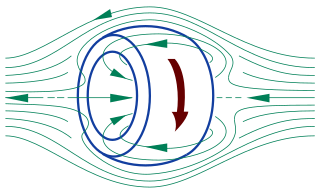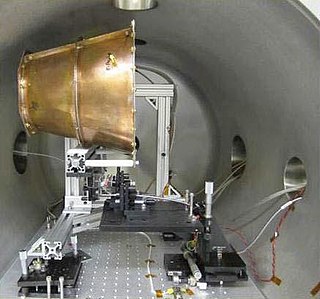Related Research Articles

Spacecraft propulsion is any method used to accelerate spacecraft and artificial satellites. In-space propulsion exclusively deals with propulsion systems used in the vacuum of space and should not be confused with space launch or atmospheric entry.

In spacecraft propulsion, a Hall-effect thruster (HET) is a type of ion thruster in which the propellant is accelerated by an electric field. Hall-effect thrusters are sometimes referred to as Hall thrusters or Hall-current thrusters. Hall-effect thrusters use a magnetic field to limit the electrons' axial motion and then use them to ionize propellant, efficiently accelerate the ions to produce thrust, and neutralize the ions in the plume. The Hall-effect thruster is classed as a moderate specific impulse space propulsion technology and has benefited from considerable theoretical and experimental research since the 1960s.

An ion thruster, ion drive, or ion engine is a form of electric propulsion used for spacecraft propulsion. An ion thruster creates a cloud of positive ions from a neutral gas by ionizing it to extract some electrons from its atoms. The ions are then accelerated using electricity to create thrust. Ion thrusters are categorized as either electrostatic or electromagnetic.
A pulsed plasma thruster (PPT), also known as a Pulsed Plasma Rocket (PPR), or as a plasma jet engine (PJE), is a form of electric spacecraft propulsion. PPTs are generally considered the simplest form of electric spacecraft propulsion and were the first form of electric propulsion to be flown in space, having flown on two Soviet probes starting in 1964. PPTs are generally flown on spacecraft with a surplus of electricity from abundantly available solar energy.

BepiColombo is a joint mission of the European Space Agency (ESA) and the Japan Aerospace Exploration Agency (JAXA) to the planet Mercury. The mission comprises two satellites launched together: the Mercury Planetary Orbiter (MPO) and Mio. The mission will perform a comprehensive study of Mercury, including characterization of its magnetic field, magnetosphere, and both interior and surface structure. It was launched on an Ariane 5 rocket on 20 October 2018 at 01:45 UTC, with an arrival at Mercury planned for November 2026, after a flyby of Earth, two flybys of Venus, and six flybys of Mercury. The mission was approved in November 2009, after years in proposal and planning as part of the European Space Agency's Horizon 2000+ programme; it is the last mission of the programme to be launched.

The gridded ion thruster is a common design for ion thrusters, a highly efficient low-thrust spacecraft propulsion method running on electrical power by using high-voltage grid electrodes to accelerate ions with electrostatic forces.

A field-reversed configuration (FRC) is a type of plasma device studied as a means of producing nuclear fusion. It confines a plasma on closed magnetic field lines without a central penetration. In an FRC, the plasma has the form of a self-stable torus, similar to a smoke ring.
The helicon double-layer thruster is a prototype electric spacecraft propulsion. It was created by Australian scientist Christine Charles, based on a technology invented by Professor Rod Boswell, both of the Australian National University.
In electromagnetism, a helicon is a low-frequency electromagnetic wave that can exist in bounded plasmas in the presence of a magnetic field. The first helicons observed were atmospheric whistlers, but they also exist in solid conductors or any other electromagnetic plasma. The electric field in the waves is dominated by the Hall effect, and is nearly at right angles to the electric current ; so that the propagating component of the waves is corkscrew-shaped (helical) – hence the term “helicon,” coined by Aigrain.

A plasma propulsion engine is a type of electric propulsion that generates thrust from a quasi-neutral plasma. This is in contrast with ion thruster engines, which generate thrust through extracting an ion current from the plasma source, which is then accelerated to high velocities using grids/anodes. These exist in many forms. However, in the scientific literature, the term "plasma thruster" sometimes encompasses thrusters usually designated as "ion engines".

Spacecraft electric propulsion is a type of spacecraft propulsion technique that uses electrostatic or electromagnetic fields to accelerate mass to high speed and thus generating thrust to modify the velocity of a spacecraft in orbit. The propulsion system is controlled by power electronics.

The EmDrive is a concept for a thruster for spacecraft, first written about in 2001. It is purported to generate thrust by reflecting microwaves inside the device, in a way that would violate the law of conservation of momentum and other laws of physics. The concept has at times been referred to as a resonant cavity thruster.

Brian David Outram Anderson is Professor in the Research School of Information Sciences and Engineering at the Australian National University. His research interests include circuits, signal processing and control, and his current work focuses on distributed control of multi-agent systems, sensor network localization, adaptive and non-linear control. Professor Anderson served as President of the Australian Academy of Science from 1998 to 2002.
Atmosphere-breathing electric propulsion, or air-breathing electric propulsion, shortly ABEP, is a propulsion technology for spacecraft, which could allow thrust generation in low orbits without the need of on-board propellant, by using residual gases in the atmosphere as propellant. Atmosphere-breathing electric propulsion could make a new class of long-lived, low-orbiting missions feasible.

The Advanced Propulsion Physics Laboratory or "Eagleworks Laboratories" at NASA's Johnson Space Center is a small research group investigating a variety of theories regarding new forms of spacecraft propulsion. The principal investigator is Dr. Harold G. White.
Michael Newton Barber is a mathematician, physicist and academic. He was Vice-Chancellor of Flinders University in South Australia from 2008 until 2014.
Christine Charles is a physicist at the Australian National University in Canberra, Australia, an inventor, researcher and science communicator. Her position at the Australian National University is director of the Space Plasma, Power and Propulsion Laboratory.
ASTER is a planned space mission under development by the Brazilian Space Agency that will launch a spacecraft to orbit a near-Earth object known as (153591) 2001 SN263, a triple asteroid system. The launch is scheduled for 2025, with a rendezvous in 2024/2027.
Alec Damian Gallimore is an American aerospace engineer who has been serving as provost of Duke University since July 2023. Previously at the University of Michigan, he served as the 15th dean of engineering from 2016 to 2023 and a faculty member since 1992.
Mitchell Louis Ronald Walker II is an American aerospace engineer, researcher, and educator. As of January 1, 2024, he is the chair of the Daniel Guggenheim School of Aerospace Engineering (AE) in the College of Engineering at the Georgia Institute of Technology. Prior to serving as the chair, he was the associate dean for academic affairs at the Georgia Tech College of Engineering. He is the founder and director of the High-Power Electric Propulsion Laboratory (HPEPL) at Georgia Tech, founded in 2005. The lab aims to advance the understanding of plasma physics and expand the technology of electric propulsion devices for future space use.
References
- 1 2 Rod W. Boswell - The Story, people.physics.anu.edu.au
- ↑ "To infinity and beyond: Progress of the Australian Plasma Thruster". School Seminar Program. Research School of Physics & Engineering, Australian National University. 20 September 2012.
- ↑ "ESA and Australian team develop breakthrough in space propulsion". ESA. 18 January 2006. Retrieved 1 March 2023.
- ↑ Aidan Cornelius-Bell (18 October 2021). Student Activism in Higher Education: The politics of students' role in hegemonic university change (PDF) (Thesis). Flinders University. Retrieved 1 March 2023.
- ↑ "Plasma Science & Technology Division Plasma Prize". American Vacuum Society. Retrieved 26 January 2024.
- ↑ "Centenary Medal". It's an Honour. 1 January 2001.
- ↑ "Fellows elected in 2008". Archived from the original on 23 March 2016.
- ↑ "Boswell". People.physics.anu.edu.au. Retrieved 11 August 2015.
- ↑ "Member of the Order of Australia (AM)". It's an Honour. 26 January 2012.